Key takeaways:
- Feedback in film editing is crucial for discovering blind spots and fostering collaboration, often revealing new perspectives on the material.
- Different types of feedback—technical, emotional, and conceptual—play distinct roles in enhancing the editing process and narrative coherence.
- Receiving feedback effectively requires creating a welcoming environment, asking targeted questions, and maintaining a mindset open to growth and exploration.
- Implementing feedback involves reflection, creating checklists for suggestions, and using constructive criticism as motivation for deeper revisions.
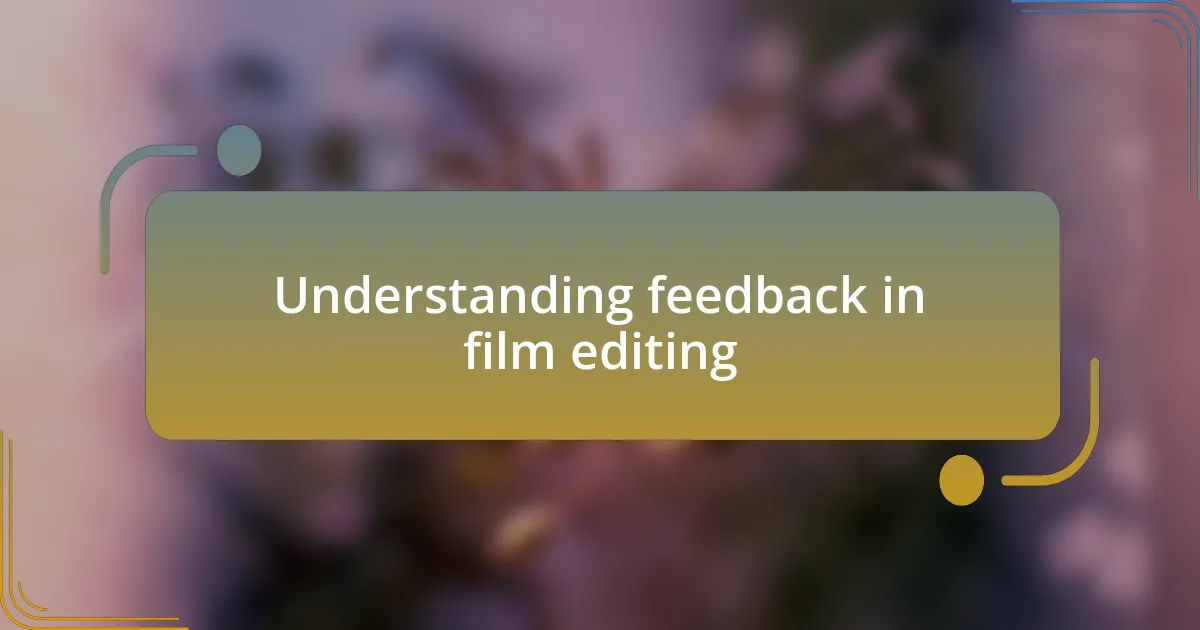
Understanding feedback in film editing
Feedback in film editing is essential for honing one’s craft. I remember a project where I poured my heart into the cut, believing it was flawless. However, when I shared it with a colleague, their insights illuminated areas I had overlooked, reminding me that collaboration often reveals blind spots that we can’t see alone.
There’s something profound about the vulnerability of opening your work to critique. I recall feeling apprehensive the first time I presented my edits to a seasoned director. To my surprise, their feedback was not just critical; it was a conversation that sparked new ideas and inspired me to look at the footage from different angles. Isn’t it fascinating how feedback can act like a mirror, reflecting opportunities for growth that we might be too close to recognize?
Understanding feedback also involves embracing the emotional journey that comes with it. When revisions feel overwhelming, I remind myself of the excitement in exploring new possibilities. I ask questions like, “How can this enhance the story?” or “What if I approached it this way?” This mindset transforms feedback from a daunting task into an adventure, paving the way for creativity and innovation in my editing process.
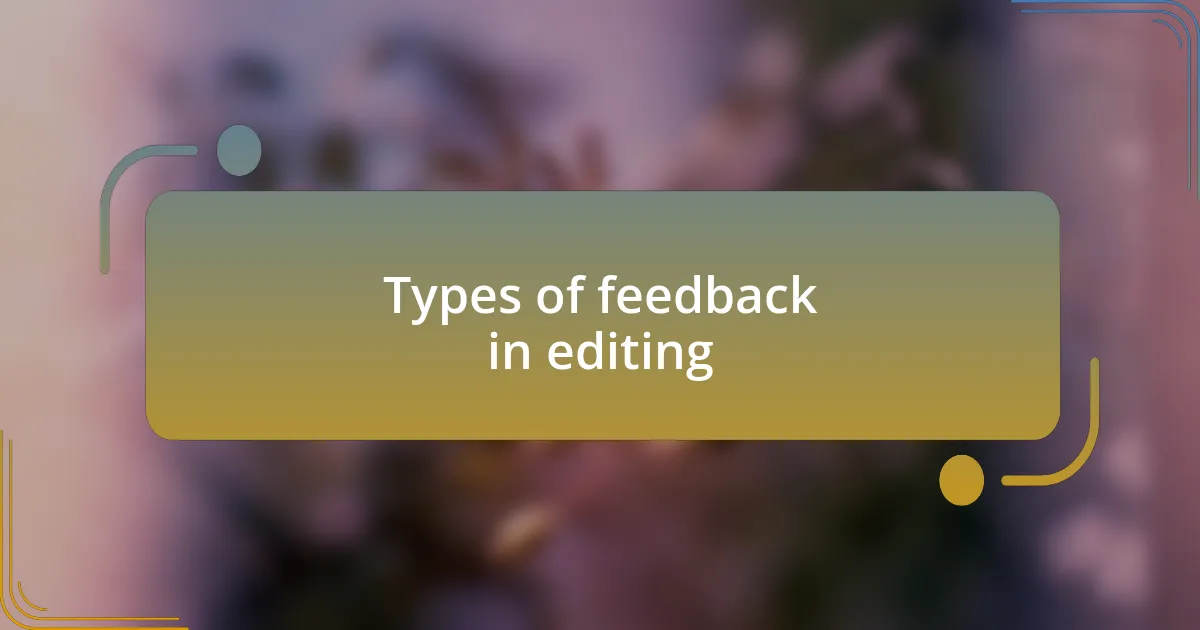
Types of feedback in editing
Feedback in editing can be categorized into several types, each playing a distinctive role in the creative process. There’s the technical feedback, where experienced editors or sound engineers provide insights on pacing, transitions, and overall flow. I remember a time when a sound designer pointed out moments that disrupted the rhythm of my edit. Their technical perspective helped me refine the sequence and elevate the emotional impact of the scene.
Emotional feedback is another crucial type that often stems from test screenings or peer reviews. After sharing my edit with a small group of friends, I was struck by their reactions to specific scenes. One moment that I thought would resonate fell flat for them. This kind of feedback was a wake-up call for me. It made me ponder: how does the audience truly connect with the material? Recognizing the emotional pulse of my edits became an essential part of my revision process.
Lastly, there’s conceptual feedback, which dives into the storytelling aspect. I once had a mentor who challenged me to think beyond the footage. “What is the story you want to tell?” he asked. This made me realize that editing is not just about cutting scenes but about weaving a narrative. I often reflect on this when I encounter conceptual feedback. It’s a reminder to stay true to the vision while also being open to new interpretations that can strengthen the narrative.
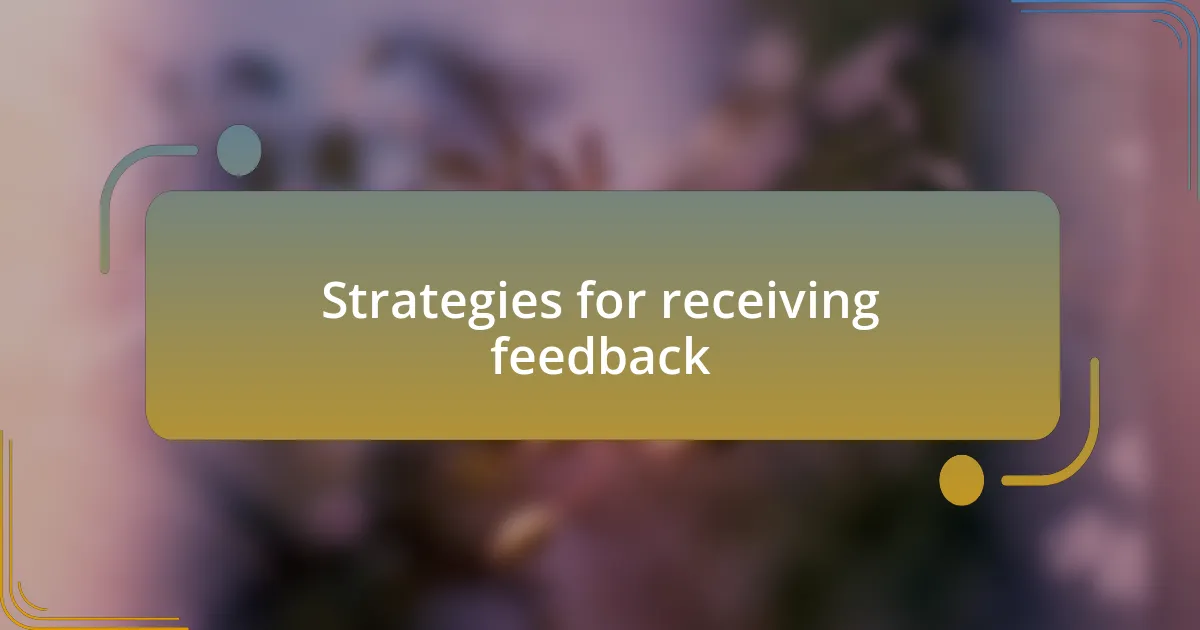
Strategies for receiving feedback
Receiving feedback can be challenging, but I’ve learned it’s crucial to create a welcoming environment. One strategy I use is to ask targeted questions when sharing my work. For example, I often say, “What do you think about the pacing in this scene?” This not only makes feedback more focused but also encourages others to reflect on specific elements of my edit, which provides me with deeper insights.
I’ve also found that building relationships with my feedback providers enhances the quality of the critiques I receive. When I established regular editing sessions with fellow filmmakers, we created a space where candid discussions could flourish. I remember one instance where a trusted colleague pointed out a subtle inconsistency in a character’s motivation that I had overlooked. Their honesty, backed by our mutual respect, led me to make significant improvements.
Moreover, I try to embrace a mindset of curiosity rather than defensiveness. After screening a rough cut, I occasionally feel a twinge of anxiety, wondering how my choices will be received. By reminding myself that feedback is an opportunity for growth rather than personal criticism, I can better absorb valuable perspectives. How many times have we shied away from feedback because of fear? Shifting my perspective has transformed my editing process into an exploration of collaboration and development.
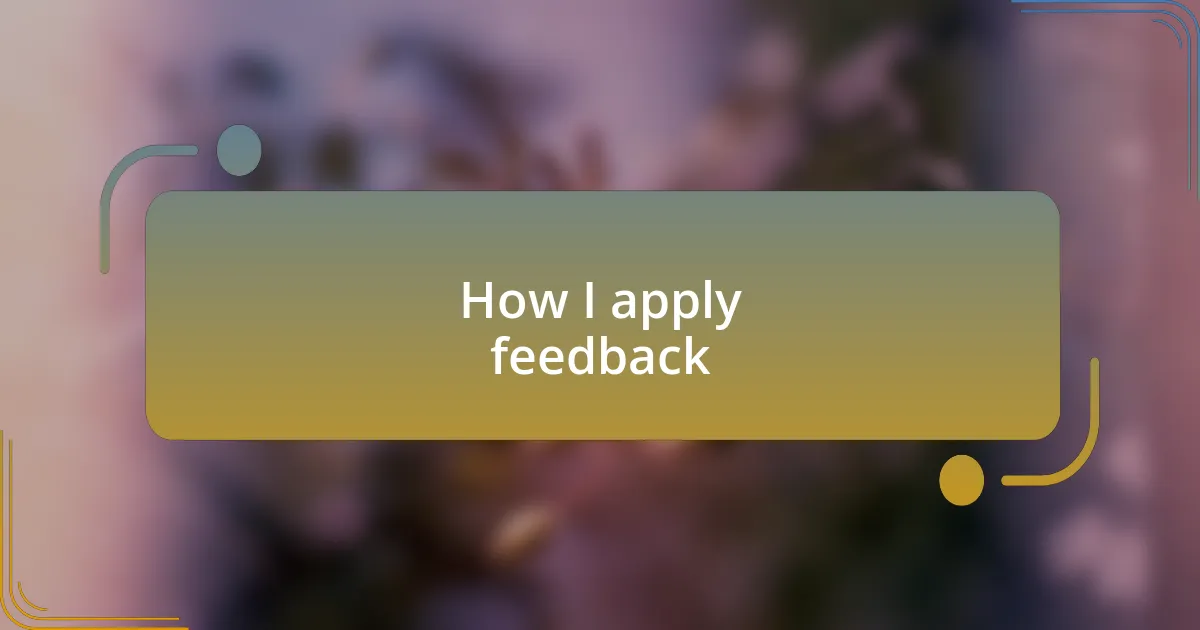
How I apply feedback
When I receive feedback, I like to take time to reflect on it before implementing changes. For instance, after screening a recent project, a colleague pointed out that a particular scene felt rushed. Initially, my instinct was to dismiss this, but I took a step back and watched the scene again. Realizing they were spot on, I adjusted the pacing, adding a few seconds of silence that truly enhanced the emotional weight of the moment.
As I apply feedback, I often create a checklist based on the suggestions I receive. This checklist serves as a tangible reminder of areas that need attention. I recall a project where a mentor suggested improving character arcs. By breaking down each character’s journey into key moments, I was able to see inconsistencies more clearly. It felt like putting together a puzzle that suddenly revealed the bigger picture.
There are times when feedback stings a bit, right? I’ve faced comments that made me question my approach. Yet, I’ve learned to channel that discomfort into motivation. Once, after receiving particularly tough critique on a dialogue scene I was proud of, I dug deeper. I rewrote it entirely and ended up creating a moment that resonated even more profoundly with the audience. That experience taught me that some of the best edits come from the most challenging feedback.
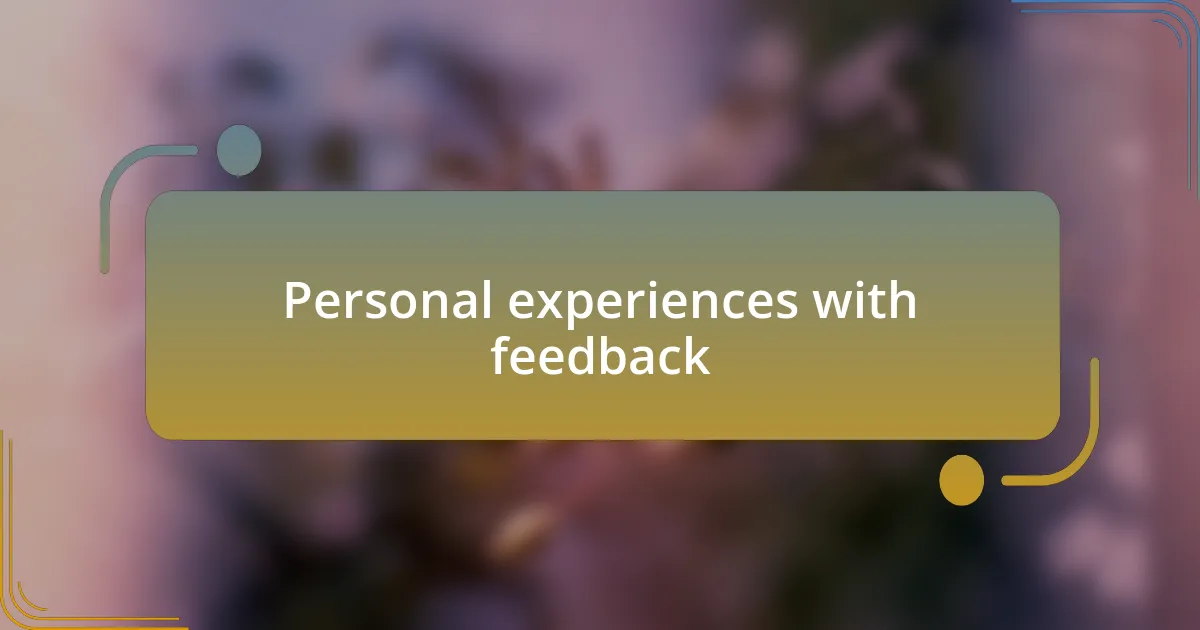
Personal experiences with feedback
When I first started receiving feedback, I often felt a mix of vulnerability and excitement. I remember screening my short film at a local festival, and while the applause was heartwarming, the feedback from a seasoned filmmaker struck deeply. They mentioned a lack of clarity in the storyline, which was hard to swallow at first. But once I processed that criticism, I realized it was a pivotal moment for growth. It pushed me to rework the narrative structure, ultimately leading to a much stronger, more cohesive story.
There was this one instance where I received feedback on a character’s motivations that left me pondering for days. A peer noted that the protagonist’s journey didn’t fully resonate with them. At first, I was frustrated—how could they not see the depth I envisioned? Yet, that frustration turned into a reflective journey, allowing me to dive deeper into the character’s psyche. I rewrote several scenes, and the end result was a character that felt more authentic and relatable. It taught me the power of stepping back and viewing my work through someone else’s lens.
Have you ever felt overwhelmed by feedback? I remember grappling with conflicting opinions after a workshop. One mentor loved a specific scene while another thought it detracted from the overall narrative. Instead of becoming paralyzed by indecision, I used this feedback as a guidepost. I went back to the drawing board, exploring both perspectives and ultimately merging the strengths of each. This experience reinforced my belief that even contradictory feedback can lead to profound insights if approached with an open mind.
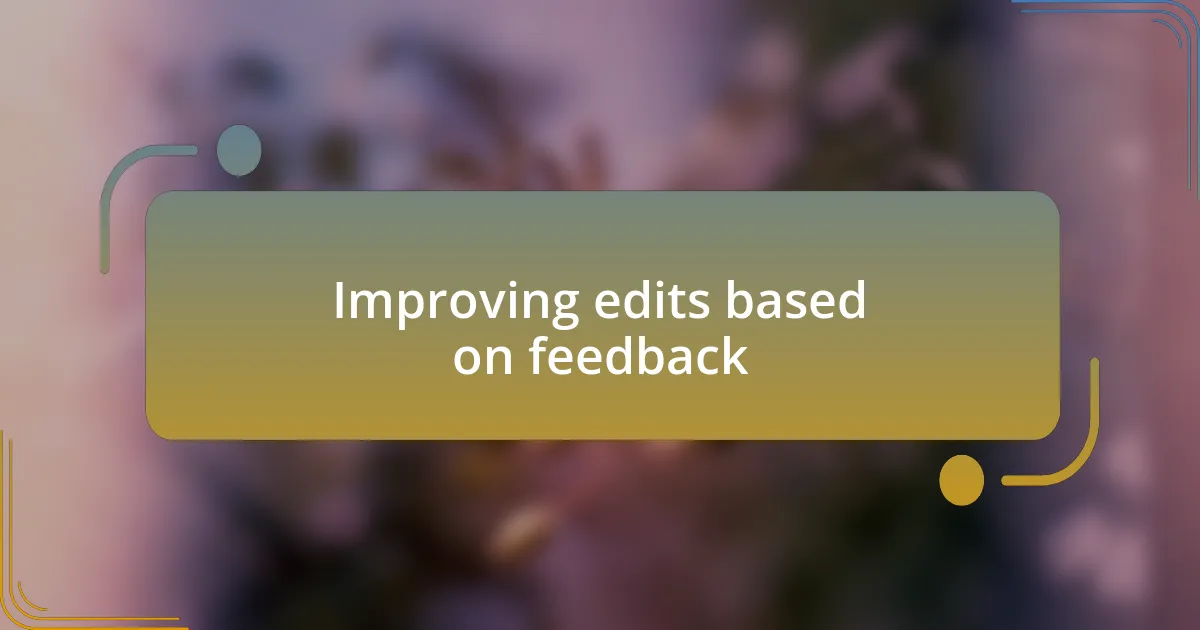
Improving edits based on feedback
Receiving feedback is like opening a door to new possibilities in my edits. I vividly recall a time when a mentor pointed out that the pacing in my documentary felt sluggish. Initially, I bristled at the suggestion, but as I revisited the footage, I recognized the truth in their observation. I meticulously cut down scenes that dragged on, and what emerged was a tighter, more engaging narrative that kept viewers on the edge of their seats. Isn’t it fascinating how a single piece of constructive criticism can spark such a dramatic transformation?
Another memorable instance involved a colleague who suggested that my film’s tone was inconsistent. At first, I was disheartened; I thought I had crafted a unique emotional journey. However, instead of dismissing the feedback, I spent time reflecting on the emotional beats I wanted to convey. This introspection led me to tweak the sound design and color grading, which harmonized the overall tone of the piece. Could I have achieved the same level of cohesion without that external perspective? Probably not.
I often find that a fresh set of eyes can reveal blind spots I wouldn’t have considered otherwise. One time, after screening a nearly finished cut, an audience member remarked that a particular subplot felt underdeveloped. The comment hit home, igniting a spark of creativity. I decided to dive deeper into that subplot, even rewriting a couple of key scenes to flesh it out more robustly. The result was a richer narrative tapestry that resonated with viewers in ways I hadn’t anticipated. Isn’t it remarkable how feedback can shift our focus and lead to deeper storytelling?